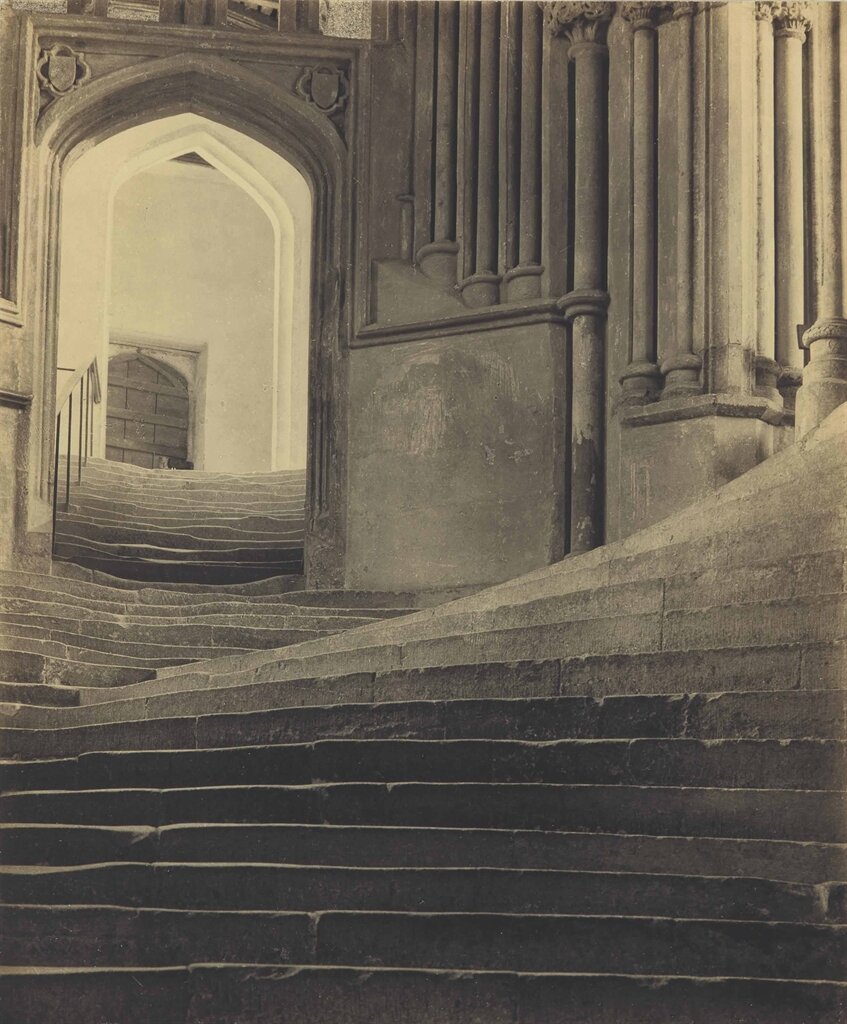To see a sea of steps
For as long as I can remember, I have been aware of the photograph known as “The Sea of Steps”. This image was made in 1903 by the early English photographer Frederic Evans. Evans had been a keen amateur photographer since the 1880. His specialism was the cathedrals of Britain and France. He gave up running his book shop in London when in 1887 he was given the chance to exhibit at the Architectural Club in Boston in 1887 (aged 45) to pursue photography as his full-time profession.In 1900, he had his first solo exhibition at The Royal Photographic Society and was elected to the Linked Ring Group which boosted his reputation beyond compare. In 1903, he was invited by Alfred Stieglitz to have his work featured in the new Camera Work journal. This was accompanied by an essay by George Bernard Shaw.It was this year (1903) that Evans created his iconic image. The photograph is simply of the steps that lead up to and past the Chapter House in Wells Cathedral. These steps show many hundreds of years wear by members of the chapter and clergy, pupils from the Cathedral School in Wells (of which I was one for 5 years) and now, the hundreds of thousands of people who visit the cathedral every year.The steps appear to flow up and around the corner into the chapterhouse hence the name “Sea of Steps”. The composition is fairly simple, but very well balanced. It obeys the rule of thirds and the “magic ratio” in equal measure. He has managed to keep the verticals parallel, and importantly, the tonal reproduction is stunning.I have only once seen an original (printed by Evans)on display at the Royal Photographic Society in Bath although there is a very nice later print in the chained library in Wells Cathedral. Original prints (of which I believe there were only 5 or so) command a huge price. The last one that sold as far as I’m aware was sold by Sotheby’s in New York in 2013 for $233,000. This puts it slightly out of the grasp of the average collector. Apparently though, this was for a silver gelatine print which bizarrely is rarer as he preferred to print using the far more expensive, but beautiful Platinum process.In 2015 I was given permission by the cathedral to produce a series of images of the cathedral with the intention of having an exhibition of them in there at some point. After completing the nave and the chapterhouse, I next moved onto the famous steps.My technique was slightly different to that of Evans given that he used a traditional plate camera, producing large glass negatives that would then be contact printed onto the paper in his darkroom at a later date. Even though I was using modern equipment, my remit to myself was to do as I believe Evans would’ve done had he been around today.My equipment for the shoot was my old (it’s not dead yet) Canon 5d mk2 and the fantastic Canon 24mmTSE2 lens. This lens allows all of the movements (tilt, shift, yaw etc.) that are available on a modern large format camera and are probably comparable to what was available to Evans. This was all fixed to my trusted Manfrotto 55 tripod. Interestingly (well, I think so) I use the screen on the back of the camera to compose shots like this (with grid lines turned on), so I am working almost as I would with a large format camera, just without the smelly cloth over my head.I worked quite methodically to try and find the exact place where Evans would have placed his tripod. I later found out that when the image became popular at first, marks were made in the floor, so photographers could easily find Evans’s spot. I didn’t know this at the time, so had none of this luxury.I can’t tell you the exact settings for my camera as I work in quite an erratic way, just spinning dials until it all clicks into place. All I know is that I shot at ISO200 with the lens shifted upwards with no tilt. I also used 4 separate spirit levels to ensure that the verticals were (err, well) vertical. The image was then processed very lightly in a mix of Adobe Lightroom, Photoshop and importantly the amazing Alien Skin Exposure software. This enabled me to apply the grain structure and contrast etc. of Fuji Acros 100 film (which is a favourite still in my analogue camera). I also used this software to give the image the subtle toning of platinum prints.I am quite happy with my finished image. I have achieved a slightly wider image area than the Evans original, but kept the same perspective. This is due to the limitations of the older lenses compared to my modern architectural specialist glass. I am quite happy that if it had been possible, Evans would have tried to include this extra detail.In researching for this image, I did the ubiquitous google image searches. Most of the images found, either used very wide lenses, low angles or other techniques that add nothing to the image and in my opinion look a tad tacky. I have always had a thing about odd camera angles and “special” effects and am of the opinion the just because you can, doesn’t mean you should.My ultimate plan for this image would be to have a genuine platinum print made from the file and have it presented in the same way as the originals I have seen. Maybe one day my prints may find their way into the cathedral library along with their inspiration.All of my cathedral images so far can be seen at: http://www.andrewchamberlain.co.uk/-/galleries/prints/wells-cathedral-prints/-/medias/1488014f-b631-4b62-8eb7-3e90187aed2b

